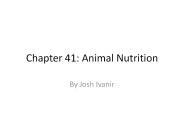Chapter 8 Carbohydrates - PowerPoint PPT Presentation
1 / 41
Title:
Chapter 8 Carbohydrates
Description:
Starch is a mixture of amylose (unbranched) and amylopectin (branched every 25 sugars) ... Amylose and Amylopectin form helical structures. in starch granules ... – PowerPoint PPT presentation
Number of Views:225
Avg rating:3.0/5.0
Title: Chapter 8 Carbohydrates
1
Chapter 8 - Carbohydrates
- Carbohydrates (hydrate of carbon) have
empirical formulas of (CH2O)n , where n 3 - Monosaccharides one monomeric unit
- Oligosaccharides 2-20 monosaccharides
- Polysaccharides gt 20 monosaccharides
- Glycoconjugates linked to proteins or lipids
- Trioses - 3 carbon sugars
- Tetroses - 4 carbon sugars
- Pentoses - 5 carbon sugars
- Hexoses - 6 carbon sugars
2
Fig. 8.3
- Trioses - 3 carbon sugars
3
Fig. 8.3
- Tetroses - 4 carbon sugars
4
Fig. 8.3
- Pentoses - 5 carbon sugars
5
Fig. 8.3
- Pentoses - 5 carbon sugars
6
Fig 8.3
- Hexoses - 6 carbon sugars
7
Fig 8.3
- Hexoses - 6 carbon sugars
8
Enantiomers and epimers
- D-Sugars predominate in nature
- Enantiomers - pairs of D-sugars and L-sugars
- Epimers - sugars that differ at only one of
several chiral centers - Example D-galactose is an epimer of D-glucose
9
Fig 8.7 (a) Pyran and (b) furan ring systems
- (a) Six-membered sugar ring is a pyranose
- (b) Five-membered sugar ring is a furanose
10
Fig 8.8 Cyclization of D-glucose to form
glycopyranose
In aqueous solution hexoses and pentoses will
cyclize, forming alpha (a) and beta (b) forms
11
Fig 8.9 Cyclization of D-ribose to form a- and
b-D-ribopyranose and a- and b-D-ribofuranose
12
8.4 Derivatives of Monosaccharides
- Many sugar derivatives are found in biological
systems - Some are part of monosaccharides,
oligosaccharides or polysaccharides - These include sugar phosphates, deoxy and amino
sugars, sugar alcohols and acids
13
Sugar Phosphates
Fig 8.13 Some important sugar phosphates
14
Deoxy Sugars
- In deoxy sugars an H replaces an OH
- Fig 8.14 Deoxy sugars
15
Amino Sugars
- An amino group replaces a monosaccharide OH
- Amino group is sometimes acetylated
- Amino sugars of glucose and galactose occur
commonly in glycoconjugates
16
Sugar Alcohols (polyhydroxy alcohols)
- Sugar alcohols carbonyl oxygen is reduced
- Fig 8.16 Several sugar alcohols
17
Sugar Acids
- Sugar acids are carboxylic acids
Fig 8.17 Sugar acids derived from glucose
18
Sugar Acids
- L-Ascorbic acid (Vitamin C) is derived from
D-glucuronate
L-Ascorbic acid (Vitamin C)
Fig 8.18 L-Ascorbic acid
19
Disaccharides and Other Glycosides
- Glycosidic bond - primary structural linkage in
all polymers of monosaccharides - Glucosides - glucose provides the anomeric carbon
Fig 8.20 Structures of disaccharides (a)
maltose, (b) cellobiose
20
Fig 8.20 Structures of disaccharides (c) lactose,
(d) sucrose
21
Polysaccharides
- Homoglycans - homopolysaccharides containing
only one type of monosaccharide - Heteroglycans - heteropolysaccharides containing
residues of more than one type of monosaccharide - Lengths and compositions of a polysaccharide may
vary within a population of these molecules
22
(No Transcript)
23
Starch
- D-Glucose is stored intracellularly in polymeric
forms - Plants and fungi store glucose as starch
- Starch is a mixture of amylose (unbranched) and
amylopectin (branched every 25 sugars)
- Amylose is a linear polymer
- Figure 8.22
- Amylopectin is a branched polymer
- Figure 8.23
24
Amylose and Amylopectin form helical structures
in starch granules of plants
25
Starch is stored by plants and used as fuel.
26
Glycogen is is stored by animals and used as fuel.
27
Glycogen
Glycogen is the main storage polysaccharide of
humans. Glycogen is a polysaccharide of glucose
residues connected by a -(1-4) linkages with a
-(1-6) branches (one branch per 10
sugars). Glycogen is present in large amounts in
liver and skeletal muscle.
28
Cellulose, a structural polysaccharide in plants
has b-(1-4) glycosidic bonds
Fig 8.25 Structure of cellulose
29
Fig 8.26 Cellulose fibrils
- Intra- and interchain Hydrogen bonds give strength
30
Humans digest starch and glycogen ingested in
their diet using amylases, enzymes that
hydrolyze a-(1-4) glycosidic bonds. Humans
cannot hydrolyze b-(1-4) linkages of cellulose.
Therefore cellulose is not a fuel source for
humans. It is fiber. Certain microorganisms
have cellulases, enzymes that hydrolyze b-(1-4)
linkages of cellulose. Cattle have these
organisms in their rumen. Termites have them in
their intestinal tract.
31
Fig 8.27 Structure of chitinThe exoskeleton of
arthropods
- Repeating units of b-(1-4)GlcNAc residues
GlcNAc N-acetylglucosamine
32
Glycoconjugates
- Heteroglycans appear in 3 types of
glycoconjugates - 1. Proteoglycans
- 2. Peptidoglycans
- 3. Glycoproteins
33
Proteoglycans
- Proteoglycans - glycosaminoglycan-protein
complexes - Glycosaminoglycans - unbranched heteroglycans of
repeating disaccharides of amino sugars
(D-galactosamine or D-glucosamine)
34
Fig 8.28 Repeating disaccharide of hyaluronic
acid, a glycosaminoglycan
- GlcUA D-glucuronate
- GlcNAc N-acetylglucosamine
35
Fig 8.29 Proteoglycan aggregate of cartilage
36
Peptidoglycans
37
Fig 8.30 Glycan moiety of peptidoglycan
38
Fig 8.31 Structure of the peptidoglycan of the
cell wall of Staphylococcus aureus
(a) Repeating disaccharide unit, (b)
Cross-linking of the peptidoglycan macromolecule
39
Penicillin inhibits a transpeptidase involved in
bacterial cell wall formation
- Fig 8.32 Structures of penicillin and
-D-Ala-D-Ala - Penicillin structure resembling -D-Ala-D-Ala is
shown in red
40
Glycoproteins
- Proteins that contain covalently-bound
oligosaccharides, either to serine (O-Glycosidic
linkage) or asparagine (N-glycosidic linkage) - Oligosaccharide chains exhibit great variability
in sugar sequence and composition
Fig. 8.33 O-Glycosidic and N-glycosidic linkages
41
Fig 8.34 and 8.35. Types of glycosidic linkages































